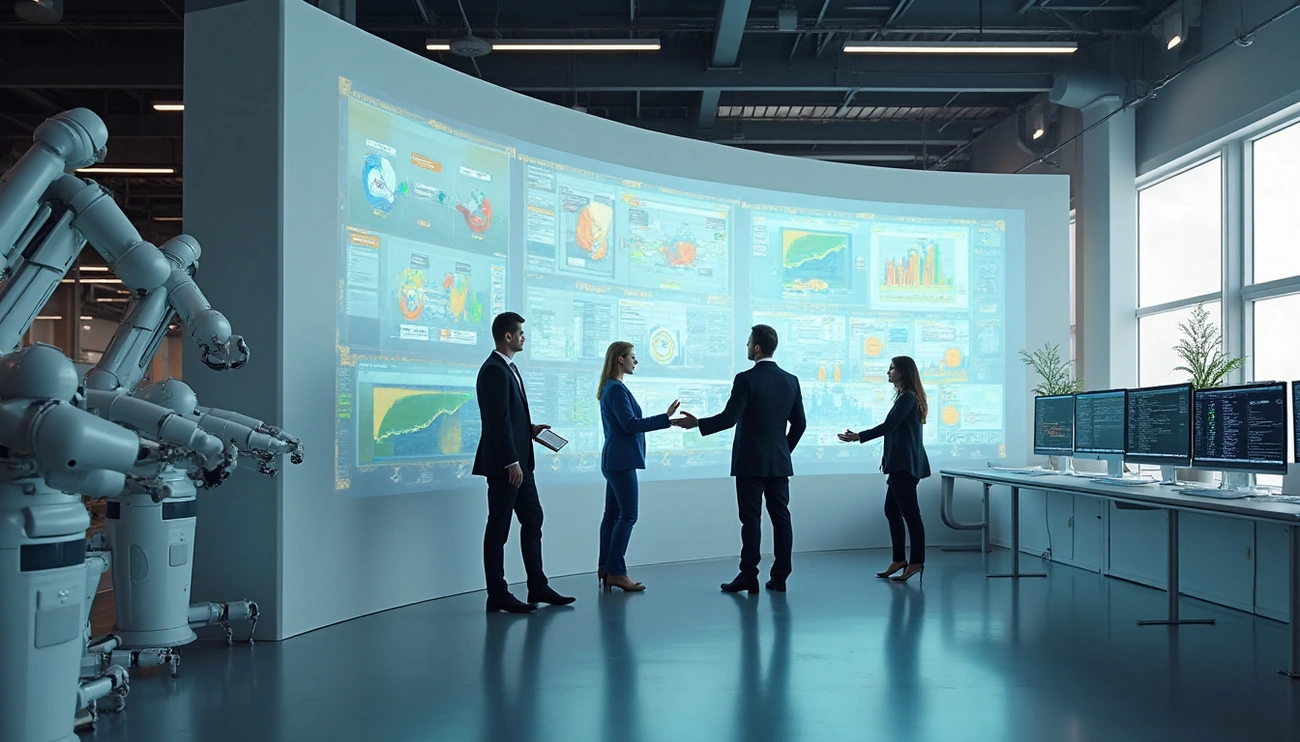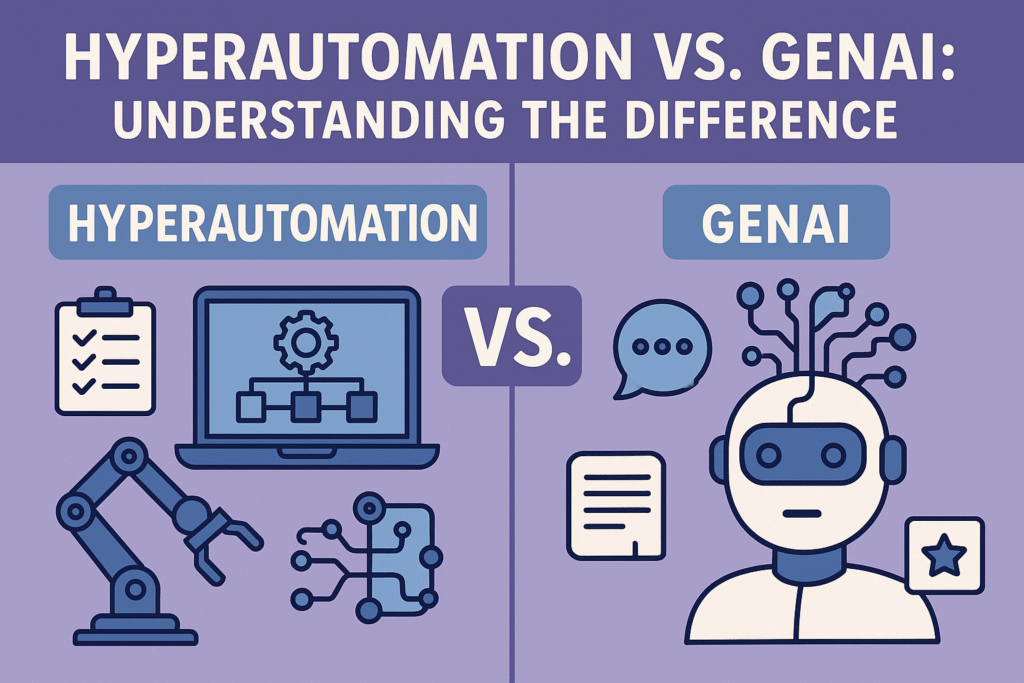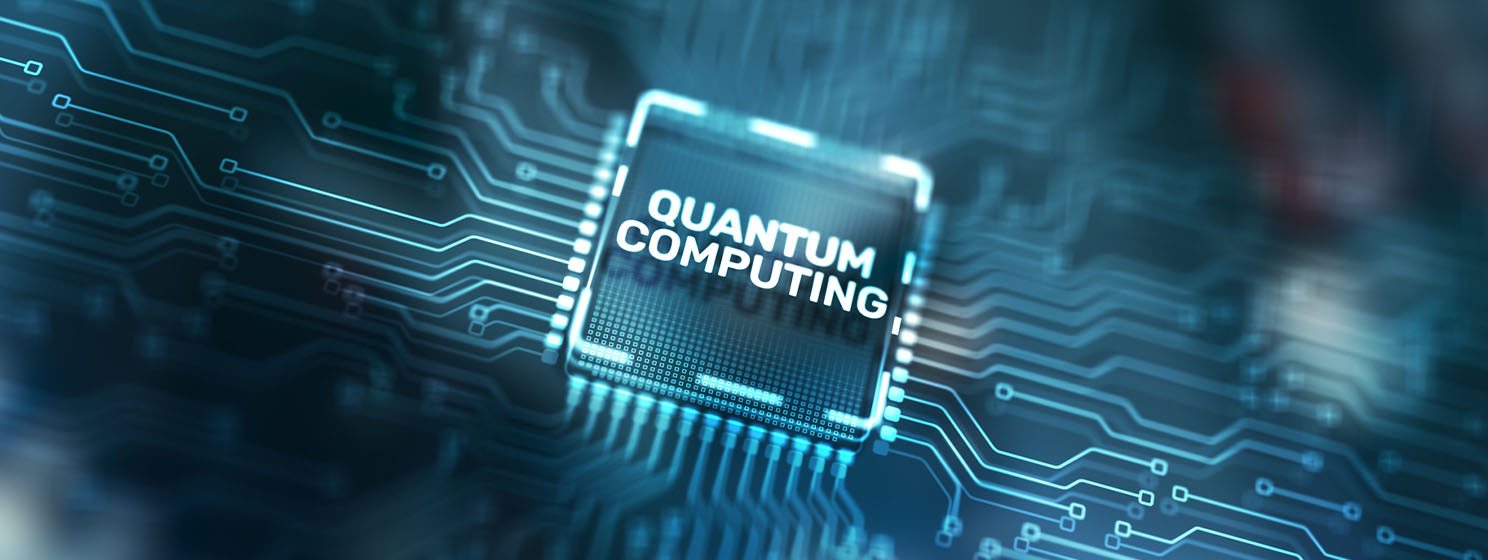Hyperautomation vs GenAI: Why It Matters More in 2025?

Hyperautomation vs GenAI is becoming one of the most important technology debates of 2025. While GenAI continues to capture headlines, hyperautomation is quietly emerging as a critical driver of enterprise transformation. The benefits are significant—with the market projected to reach USD 270.63 billion by 2034. According to Gartner, who coined the term, “Hyperautomation is rapidly shifting from an option to a condition of survival.”
Moreover, over 56% of organizations already have four or more hyperautomation initiatives underway, and 85% plan to sustain or increase their investments soon. By 2026, 30% of enterprises will automate over half their network activities, further underlining hyperautomation’s critical role.
Hyperautomation vs. GenAI: Understanding the Difference
What is Hyperautomation?
Hyperautomation integrates robotic process automation (RPA), artificial intelligence (AI), machine learning (ML), process analytics, low-code/no-code platforms, and systems that responds automatically to change into cohesive automation accross the entire organisation. Thus, it represents a disciplined, business-driven strategy that automates entire workflows comprehensively.
In contrast, Generative AI (GenAI) specializes in content creation, language comprehension, and data pattern analysis. While it boosts creativity and innovation, it is limited to narrower, task-specific applications.
Why This Distinction Matters?
Therefore, businesses must grasp these differences clearly to allocate their digital investments strategically. Hyperautomation delivers measurable outcomes such as:
- Operational cost reductions of up to 30%
- Increased employee satisfaction by automating tedious tasks
- Enhanced compliance through real-time monitoring
- Greater agility and long-term competitive edge
On the other hand, GenAI, while impressive and media-friendly, does not offer the extensive operational transformation that hyperautomation provides.

Key Technologies Behind Hyperautomation vs GenAI Strategies
Hyperautomation relies on an integrated stack of technologies that, when combined, enable enterprise-scale transformation. These include:
- Robotic Process Automation (RPA): Automates repetitive, structured tasks, laying the foundation for advanced automation when combined with AI.
- Artificial Intelligence & Machine Learning (AI/ML): Enable systems to adapt and learn over time, thereby handling complex, unstructured data.
- Intelligent Document Processing (IDP): Automates the extraction and processing of unstructured documents, often achieving up to 99.9% accuracy and significantly reducing processing time.
- Low-code/No-code Platforms: Democratize automation efforts by allowing non-technical users to build workflows rapidly.
- Advanced Analytics & AI Agents: Offer real-time insights, cognitive automation, and proactive decision-making through seamless system integrations.
In comparison, GenAI tools mainly operate in creative domains and lack the orchestration capabilities necessary for end-to-end process automation.
These foundational tools form the backbone of both Hyperautomation vs GenAI strategies, although their applications differ significantly.
Top 6 Benefits of Hyperautomation Over GenAI
1. End-to-End Process Automation
Unlike GenAI, hyperautomation automates entire workflows, thereby removing bottlenecks and ensuring smooth operations across departments.
2. Real-Time Decision Making
Because hyperautomation includes continuous data monitoring and analysis, businesses can anticipate issues and make proactive decisions.
3. Scalability and Flexibility
Moreover, hyperautomation adapts rapidly to business changes, supporting organizational growth without extensive resource reallocation.
4. Improved Compliance and Risk Management
Thanks to real-time tracking and continuous monitoring, hyperautomation enhances compliance while proactively mitigating risks.
5. Higher Employee Productivity and Satisfaction
By eliminating repetitive and mundane tasks, it allows employees to focus on strategic, value-added activities. As a result, morale and retention significantly improve.
6. Superior Customer Experience
Consequently, customers benefit from faster, personalized services, which boosts overall satisfaction and loyalty.
The following case studies highlight how businesses are choosing Hyperautomation vs GenAI depending on their specific operational goals.
Hyperautomation vs GenAI: Real-World SME Use Cases and Benefits
Finance: Efficient Loan and Invoice Processing
For example, an SME financial services firm automated their invoice and loan approval processes using RPA and AI. As a result, loan approval times were reduced from days to mere hours, and invoice processing time dropped by 85%.
Healthcare: Streamlined Patient Management
Similarly, a small healthcare clinic used hyperautomation to manage appointments and billing. AI-powered virtual agents handled scheduling, while intelligent document processing streamlined billing and claims. Consequently, staff had more time to focus on patient care.
E-commerce: Improved Inventory Management
A growing e-commerce SME implemented AI-driven analytics to automate inventory tracking. As a result, fulfillment became faster, stockouts were reduced, and operational costs dropped by up to 30%.
IT Services: Proactive System Maintenance
Furthermore, an SME IT solutions provider adopted hyperautomation tools like automated system monitoring and RPA-driven maintenance. This significantly reduced downtime and human error, thereby improving client satisfaction.
Manufacturing: Predictive Equipment Maintenance
In another case, a manufacturing SME leveraged real-time analytics to schedule predictive maintenance for machinery. As a result, unexpected breakdowns were minimized, leading to improved productivity and cost savings.
Conclusion: Why Hyperautomation Wins the Hyperautomation vs GenAI Debate in 2025
In summary, while GenAI continues to capture media attention, hyperautomation is the true transformative force businesses must prioritize heading into 2025. Unlike GenAI, which excels in narrow tasks, hyperautomation integrates diverse technologies into end-to-end solutions that deliver enterprise-wide value.
Therefore, by embracing hyperautomation, businesses gain:
- Dramatic cost savings
- Operational agility and scalability
- Enhanced compliance and reduced risks
- Improved employee satisfaction and productivity
- Exceptional customer experiences
The hyperautomation market’s projected growth trajectory makes one thing clear: it is no longer a luxury—it is a necessity for sustainable business success.
In the ongoing Hyperautomation vs GenAI conversation, one thing is clear—hyperautomation delivers more holistic, scalable, and immediate value.
Key Takeaways from the Hyperautomation vs GenAI Comparison
1. Hyperautomation automates full workflows end-to-end, while GenAI focuses on task-specific content generation.
2. The hyperautomation market is projected to reach $270.63 billion by 2034, highlighting its strategic importance.
3. Real-world benefits include cost savings, faster operations, and improved compliance across industries.
4. Technologies like RPA, AI/ML, IDP, and low-code platforms drive hyperautomation success.
5. Organizations prioritizing hyperautomation today will lead tomorrow’s digital transformation.
FAQs on Hyperautomation vs GenAI in 2025
Q1. How does hyperautomation differ from GenAI?
Hyperautomation integrates multiple technologies to automate entire workflows, while GenAI is specialized in content generation and creative tasks.
Q2. What are the key technologies driving hyperautomation?
RPA, AI/ML, Intelligent Document Processing, low-code/no-code platforms, and advanced AI agents.
Q3. How does hyperautomation benefit businesses compared to traditional automation?
It enables comprehensive process automation, real-time decision-making, scalability, compliance, improved employee productivity, and better customer experiences.
Q4. In which industries is hyperautomation significantly impactful?
Finance, healthcare, e-commerce, IT operations, and manufacturing, among others.
Q5. Why is hyperautomation essential for business survival in 2025?
Because it provides agility, cost-efficiency, real-time insights, and operational excellence necessary to stay competitive in rapidly evolving markets.
Ready to future-proof your business with hyperautomation?
Let our experts at Hepmade Solutions help you identify automation opportunities tailored to your unique needs.
👉 Contact us today or schedule a free consultation to begin your automation journey.
#HyperautomationvsGenAI #EnterpriseAutomation #AIinBusiness #DigitalTransformation #AutomationStrategy #ProcessAutomation #IntelligentAutomation

Don't miss Our Update. Subscribe us for more info.
Request Quote
What type of solution you are seeking?
Please Select One
Your estimated budget
Please Select One
 Hepmade
Hepmade 
 Automation
Automation 



